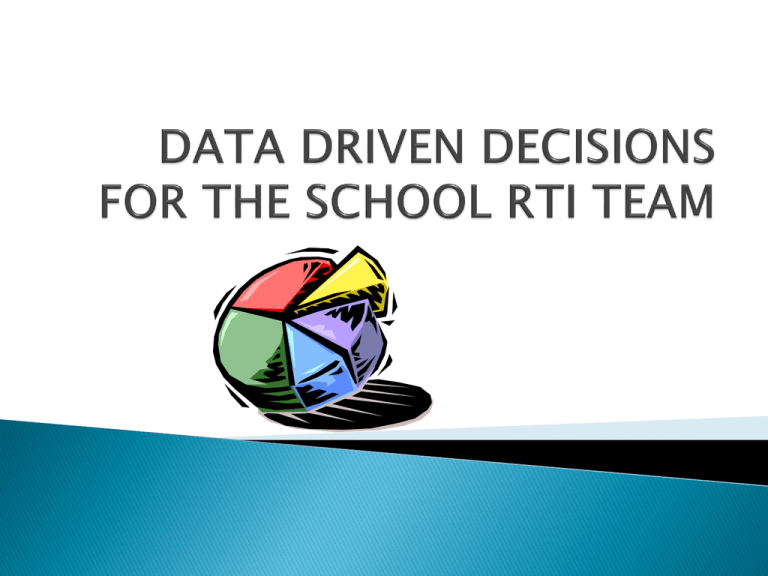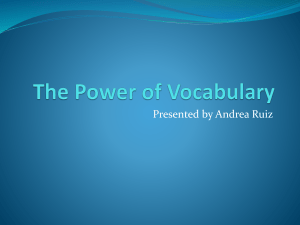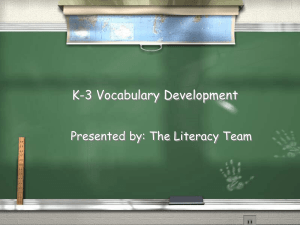Data Driven Decision Making for the RTI Team Power Point
advertisement

The focus of this session is data! Locate the “Show Me Your Data” handout. Gather the data from your sheet. Hold on to your data! We are going to do some comparisons. Please be sure you signed in the session. Turn your cell phones to vibrate. Get all of the handouts and organize your area for active learning. Did we see/count the same things? Is our data objective or subjective? What is the difference? Response to Intervention (RTI) is a multitiered approach to help struggling learners. Students' progress is closely monitored at each stage of intervention to determine the need for further research-based instruction and/or intervention in general education, in special education, or both. http://www.rtinetwork.org/ Systems Model for Academics and Behavior Academic Systems 1-5% Intensive Individualized Interventions 5-10% Targeted Interventions 80-90% School-Wide Programming Behavioral Systems 1-5% Intensive Individualized Interventions 5-10% Targeted Interventions 80-90% School-Wide Programming Decisions about tiers of support are data-based Are you happy with your data? Let your data do the talking…. District School Grade Level Level Level Student Level We get data from the Universal Screening process. Area Source Literacy KPREP Results; Grades; Developmental Reading Assessment (DRA); Scholastic Reading Inventory (SRI); Core Content Assessments (CCAs); Program Assessments; SuccessMaker Course Level; 1-Minute Timed Reads; Phonics Screeners; MAZE Assessments; ACT Plan/Explore Teacher Observations; RDAs; RPAs Math KPREP Results; Grades; Core Content Assessments (CCAs); Program Assessments; Program Unit Tests; Classroom Work Samples; SuccessMaker Course Level; Teacher Observations; District Developed Screeners; ACT Plan/Explore; MDAs; MPAs Social Development/ Behavior Attendance; Out of School Suspension; In-School Suspension; Office Referrals; Grades; Teacher Observations OBJECTIVE DATA FROM EVERYONE CASTS A NET OVER ALL CHILDREN HELPS US “SCREEN” TO DETERMINE WHO IS AND WHO IS NOT MEETING STANDARDS “RED” FLAGS STUDENTS WHO ARE NOT ON GRADE LEVEL FOR A DEEPER REVIEW OF THEIR DATA USE MULTIPLE PIECES OF DATA KEY PIECE OF DATA IS KPREP SCORE Academics ◦ ◦ ◦ ◦ Somewhat Behind 1-2 Grade Levels Below Apprentice Range Potential to “Catch Up” within 1 School-Year Behavior ◦ Mild to Moderate Behaviors ◦ Lower Intensity & Frequency STUDENTS WHO NEED TIER 2 Academics ◦ ◦ ◦ ◦ Significantly Behind 2+ Grade Levels Below Novice Range May Need More Than 1 Year to “Catch Up” Behavior ◦ Moderate to Severe Behaviors ◦ Higher Intensity & Frequency STUDENTS WHO NEED TIER 3 FIRST LAST GRADE ECE/ESL KCCT MAP Math RTI Tier Ali Tyrone Athey Ayoub Abshir Adams Ajak Al Khafaji 06 06 06 06 ECE AM AM AH D 175 207 210 186 TIER 2 TIER 2 TIER 1 TIER 1 Mohammed Yosef Yaser Ramazan Charles Dandre Bagat Al Mosawi Al Windawi Al-Hassani Aliyev Allen Allen Anyang 06 06 06 06 06 06 06 221 TIER 1 217 214 185 207 209 202 TIER 1 TIER 1 Tier 3 TIER 2 Tier 3 Stephon Arnold 06 AL 207 TIER 2 Jonathan Jeylani Tamahji Bailey Bakari Baker 06 06 06 AL AM AL 206 TIER 2 196 193 TIER 2 TIER 3 Dakota Jose Damion Trevon Johnathan Ballard Barajas Lopez Barbour Barger Barker 06 06 06 06 06 191 Tier 3 233 222 191 206 TIER 1 TIER 1 TIER 1 Tier 3 Terriel Bryce Bartlett Basham 06 06 211 TIER 2 226 TIER 1 ESL D ESL ESL ESL ESL ESL ESL P NH AL NM AM NH ECE P P NL AL P TIER 2 Review the data to Tier the students in the building. Draw a pyramid for the school. WHAT DOES THE DATA SAY? TIER1? TIER 2? TIER 3? WHERE SHOULD EFFORTS BE PUT FOR THE SCHOOL? SEE YOU IN 10 MINUTES! Review the data for the grade level. How many students need interventions? Tier 2/Tier 3? Which teacher needs the most support because of the needs of the students? REVIEW THE DATA FOR TEACHER A, B, C OR D. HOW MANY TIER 1? HOW MANY TIER 2? HOW MANY TIER 3? WHAT WOULD YOU SUGGEST AS SUPPORT FOR THE TEACHER? WHAT KINDS OF GROUPING STRATEGIES WOULD YOU SUGGEST? WHAT KIND OF DATA SHOULD WE LOOK AT? WHAT SHOULD THE FOCUS OF THE INTERVENTION BE FOR THE STUDENT? WHAT WOULD BE THE PRIORITY STANDARDS? DO WE HAVE ENOUGH DATA? WHAT ELSE IS AVAILABLE? WHAT IF THE CHILD IS ESL? WHAT IF THE CHILD IS ECE? HOW COULD THIS DATA HELP DESIGN AN INTERVENTION PLAN OR AN IEP? WHAT DATA/NUMBER WOULD WE PROGRESS MONITOR AND GRAPH? What are the interventions going to be used? Area of Focus Basic Reading Tier 2 Tier 3 Reading Fluency Small Focus Groups Additional Small Reading Group Leveled Literacy SuccessMaker Corrective Reading Leveled Literacy Reading Comprehension Small Focus Groups Additional Small Reading Group Quick Reads Leveled Literacy Small Focus Groups Additional Small Reading Group Comprehension Plus CARS/STARS Leveled Literacy SuccessMaker Corrective Reading Leveled Literacy SuccessMaker Leveled Literacy CARS/STARS What data will set goals on and track? Area of Focus Tier 2—Once Every 2-Weeks Tier 3--Weekly Basic Reading 1-minute Timed Reads (110) Running Record Independent Text Level (38) SM Course Level (3.9) Reading Fluency 1-minute Timed Reads (110) Reading Comprehension Running Record Independent Text Level (38) Vanderbilt MAZE Probes (15) SM Course Level (3.9) We do what we said we were going to do! 90% or Better Implementation Rate Tier 1, 2 & 3 for Grades 6 & 7 Whole Group Small Group Software Independent Work 90 Minutes Daily •Average gain of Points 64 Lexile for ¼ of time in program. •Full implementation would have meant 256 Lexile Point gain for the average middle school student or moving from 569 to 825…GRADE LEVEL!!!!! Tier 2 Apprentice 3-5 Times Per Week 20 Minutes Reading, Math, Science & Social Studies In and Out of School Grade Average # of Log Ins/ Sessions Per Student Enrolled Possible Implementation Rate Blue Ribbons All Users 28 35 80% Pre: 20,642 Post: 42,819 Gain: 22,177 Tier 3, Novice 5 Times Per Week, 20 Minute Sessions In and Out of School •Based on current data full implementation would have meant the average student would have made 2.0 years gain this school year in Reading or an increase in average course level from 5.25 to 7.25…GRADE LEVEL. •Based current data full implementation in Math for March, April & May would equal .93 course level gain in Math for 2.5 months or 2.79 years gain in a school year of potential growth!!!! LOOK OVER THE SUCCESSMAKER MATH DATA PROVIDED FROM THE GROUP OF 3RD GRADERS WE LOOKED AT EARLIER. THE MINIMUM SESSIONS WHEN THIS DATA WAS PULLED SHOULD HAVE BEEN 100. WHAT IS THE IMPLEMENTATION RATE FOR THE BUILDING? HOW MANY STUDENTS MADE ENOUGH GAIN TO MOVE OUT OF INTERVENTIONS? Activity Pre Post Number of ECE Referrals 21 4 Percent Eligible for ECE Services (Hit Rate) 40% 85% SuccessMaker Reading 1.2 Gain in 26:15 on Program Mean for Building SuccessMaker Math 1.36 Gain in 24:32on Program Mean for Building Number of Tier 2 Students 87 36 Number of Tier 3 Students 69 41 % of Students Achieving Goal 25% at 1st 6-Week Grading Period 86% at 5th 6-Week Grading Period Implementation Rate 33% at 1st Grading Period 91% at 5th Grading Period Number of Suspensions Example: OCTOBER NOVEMBER CHANGE 42 21 -21 Bus Referrals Example Which bus needs help? Color October November Total Purple 2 1 3 Green 1 1 2 Yellow 4 2 6 Blue 12 14 26 Red 3 5 8 Number of Discipline Referrals by Location Example: LOCATION OCT NOV CHANGE Which AREA needs help? CAFETERIA 25 20 -5 HALLWAY 40 55 +15 CLASSROOMS 20 25 -5 1:1 Support/Visits Example Type Which 1:1 Support Type is accessed most? October November Total Office 12 20 32 Another Class 15 25 40 Beh. Coach 10 10 20 How did RTI work for our school? What features went well? What features do we need to change? Did we monitor our data efficiently and effectively? Did our Tier 2/Tier 3 students RESPOND to our interventions? How will we get better next year? Others… RTI TEAMS CAN/SHOULD USE DATA TO: ◦ DETERMINE THE SCHOOL FOCUS—MAKE A PYRAMID ◦ DETERMINE THE GRADE LEVEL NEEDS—WHICH CLASSROOMS NEED THE MOST SUPPORT? ◦ DETERMINE THE CLASSROOM NEEDS—GROUPING OF STUDENTS? ◦ DETERMINE THE INDIVIDUAL STUDENT NEEDS—AREAS OF STRENGTHS? WEAKNESS? STANDARDS TO INTERVENE? AREAS OF FOCUS? PROGRESS MONITORING? ◦ DETERMINE THE EFFECTIVENESS OF THE RTI SYSTEM— ARE STUDENTS REPSONDING TO INTERVENTIONS? WHY? WHY NOT? WHAT DO WE DO NEXT? Jefferson County Public Schools








